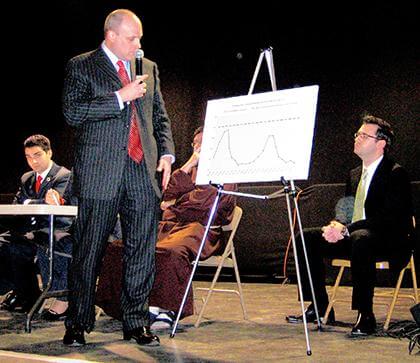By Howard Koplowitz
The decision was made to discontinue Rockaway ferry service because ridership goals were not met and the city pays too much to subsidize the service, an adviser to Mayor Michael Bloomberg said last week during a town hall meeting in Breezy Point.
The ferry was originally supposed to stop running in March, but an agreement between Bloomberg, City Council Speaker Christine Quinn (D-Manhattan), Councilman Eric Ulrich (R-Ozone Park) and other Council members in Brooklyn where the ferry stops extended the service until July 1.
The ferry was started in 2008 as a two-year pilot project.
The city looked for ridership of 300 people a day on average as a “standard of success,” said Howard Wolfson, a Bloomberg adviser and soon-to-be deputy mayor for governmental affairs. But he said between May 2008 and February 2010, the ferry failed to reach the ridership goal.
Service peaked to between 250 and 300 passengers a day from July 2008 to September 2008 and ebbed to between 100 and 150 passengers between October 2009 and February 2010.
“I think people understood even though we didn’t get to 300, we hoped we would,” Wolfson said.
He said the problem is the ferry, which costs passengers $6 each way, requires far larger subsidies than other transportation modes. The ferry is subsidized at $19.57 per rider, more than three times the rate of the Long Island Rail Road subsidy of $6.19 per person.
“In the context of other subsidies, it’s a lot of money,” Wolfson said. “We in the administration don’t have plans to continue the ferry after the [July 1] cutoff point.”
The Staten Island Ferry, which is free, is subsidized at $5.95 per rider, while New York City local and express buses are subsidized at $1.64 per passenger and subway ridership is subsidized 56 cents per person.
“We in the administration obviously have a set of hard choices,” Wolfson said, noting the city agreed the Rockaway ferry subsidy “is not the best expense for taxpayers to pay at this time.”
He added, “That’s a very difficult thing to tell people who ride the ferry.”
Wolfson said the administration is open to Council suggestions that would enable the subsidy to continue.
“We want to do right by the people … but we have a larger obligation to the city,” he said.
Ellen McCarthy, a Rockaway resident who is spearheading the effort to save the ferry, said it is heavily relied upon on the peninsula, where there is no other direct mass transit alternative. The ferry departs Riis Landing in Breezy Point at 7:45 a.m., makes a stop in Bay Ridge, Brooklyn, and docks near Wall Street.
It leaves Pier 11 in Wall Street at 5:45 p.m. and reaches Riis Landing at 6:40 p.m.
“I depend on the ferry to get to work every day,” McCarthy said. “Our ferry has been successful for those of us who ride it. It allows people to get work done on their way to work.”
McCarthy said more than 300 people have signed a petition to keep the ferry running.
Wolfson said the 300-person-a-day goal was agreed upon between the city and ferry operator, New York Water Taxi, as a number that would lower the subsidy to between $10 and $12 a person.
Quinn, who was on hand for the ferry’s maiden voyage in 2008, told the town hall there were three problems with the service: its schedule, cost and the need for another pick-up/drop-off point.
“That’s what we have to figure out in the next three months” to keep the ferry going, she said.
Reach reporter Howard Koplowitz by e-mail at hkoplowitz@cnglocal.com or by phone at 718-260-4573.

































